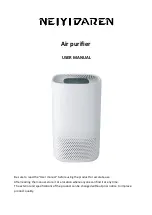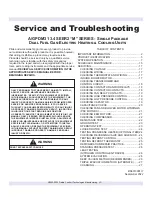
ENGLISH
*
1. Pipe length vs. vacuum pump run time
*
2. If the compound pressure gauge pointer swings back, refrigerant may have water content or a loose pipe joint may exists.
Check all pipe joints and retighten nuts as needed, then repeat steps 2) through 4).
PUMP DOWN OPERATION
In order to protect the environment, be sure to pump down when relocating or disposing
of the unit.
1) Remove the valve lids from liquid stop valve and gas stop valve.
2) Carry out forced cooling operation.
3) After five to ten minutes, close the liquid stop valve with a hexagonal wrench.
4) After two to three minutes, close the gas stop valve and stop forced cooling
Forced cooling operation
Using the indoor unit ON/OFF switch
Press the indoor unit ON/OFF switch for at least 5 seconds. (The operation will start.)
• Forced cooling operation will stop automatically after around 15 minutes.
To stop the operation, press the indoor unit ON/OFF switch.
CAUTION
Hexagonal
wrench
Close
Liquid stop valve
Gas stop valve
t
Service por
Valve lid
After closing the liquid stop valve, close the gas stop valve within 3 minutes, then stop the forced cooling operation.
To pump down
DANGER: RISK OF EXPLOSION
Pump down - Refrigerant leakage
. If you want to pump down the system, and there is a leakage in the refrigerant circuit:
• Do NOT use the unit’s automatic pump down function, with which you can collect all refrigerant from the system into
the outdoor unit. Possible consequence: Self-combustion and explosion of the compressor because of air going into the
operating compressor.
• Use a separate recovery system so that the unit’s compressor does NOT have to operate.
NOTICE
During pump down operation, stop the compressor before removing the refrigerant piping. If the compressor is still running
and the stop valve is open during pump down, air will be sucked into the system. Compressor breakdown or damage to the
system can result due to abnormal pressure in the refrigerant cycle.
11
8) Tighten valve caps and service port caps for the liquid and gas stop valves with a torque wrench at the specified torques.
7) Disconnect charging hose from gas stop valve’s service port, then fully open liquid and gas stop valves.
(Do not attempt to turn valve rod beyond its stop.)
6) Turn the liquid stop valve’s rod 90 degrees counterclockwise with a hexagonal wrench to open valve.
Close it after 5 seconds, and check for gas leakage. Using soapy water, check for gas leakage from indoor unit’s flare and outdoor unit’s flare and
valve rods. After the check is complete, wipe all soapy water off.
5) Remove covers from liquid stop valve and gas stop valve.
4) Close gauge manifold’s low-pressure valve (Lo) and stop vacuum pump. (Keep this state for a few minutes to make sure that the compound
pressure gauge pointer does not swing back.)
*
2
.
3) Do vacuum pumping and make sure that the compound pressure gauge reads - 0.1MPa (- 760mmHg)
*
1
.
2) Fully open gauge manifold’s low-pressure valve (Lo) and completely close its high-pressure valve (Hi).
(High-pressure valve subsequently requires no operation.)
1) Connect projection side of charging hose (which comes from gauge manifold) to gas stop valve’s service port.
Pipe length
Up to 15 metres
More than 15 metres
Run time
Not less than 10 min.
Not less than 15 min.






































